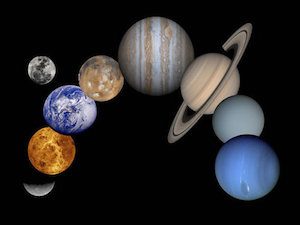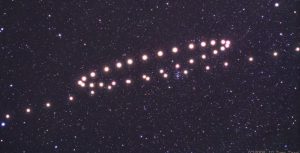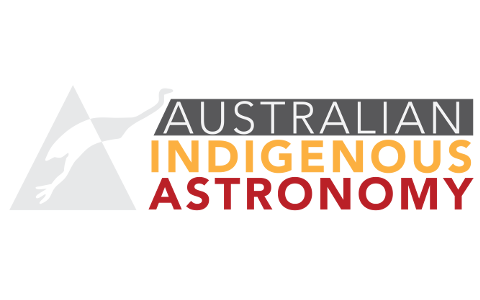The Planets

Indigenous people are careful observers of astronomical phenomena relating to the stars, Milky Way, and the planets. The Sun, Moon and visible planets (Mercury, Venus, Mars, Jupiter, and Saturn) were known to Aboriginal and Torres Strait Islander people. These cultures paid careful attention to these objects, which was recorded and passed onto successive generations through oral traditions and material culture. Aboriginal and Islander people distinguished planets from background stars, noting their changing positions in the sky, their relative positions to each other, their proximity to each other along the zodiac of the ecliptic, and their dynamic relationship to the Sun and Moon as well as other stars in the sky, and the fact that they rarely twinkled.
The planets are often seen as prominent sky ancestors and direct relations to the Sun and Moon. These relationships vary from romantic to familial relationships – and even rival relationships. To the Tiwi people, the Moon man follows the path of the Sun woman and has four wives who also follow this path. They are represented by Mars, Mercury, Venus and Jupiter. To the Kamilaroi people, Jupiter is a young boy who is disliked by his mother, the Sun. She sends men to spear the boy when he is low in the western sky. Some planets are viewed as hierarchical figures. Venus – typically represented as both the Morning and Evening Star – for example, is seen as a senior spirit and was the boss of all of the other stars. In Boorong traditions of western Victoria, Venus is Chargee Gnowee, sister of the Sun (Gnowee) and wife of Jupiter (Ginabongbearp). Ginabongbearp is chief of the the old spirits (Nurrumbunguttias).
 The path of the Sun Moon, and planets is widely known across many Aboriginal regions. It is generally seen as a road or pathway for the primary ancestor spirits. Wardaman people see it as a road ancestor spirits use to travel across the sky and is utilised for navigation. In Tiwi traditions the Sun woman carries a torch across the sky each day, from East to West (describing diurnal motion). The Moon man follows the path of the Sun woman but carries a smaller torch. Four planets – Mars, Mercury, Jupiter, and Venus – represent the Moon man’s four wives, who also travel across this pathway.
The path of the Sun Moon, and planets is widely known across many Aboriginal regions. It is generally seen as a road or pathway for the primary ancestor spirits. Wardaman people see it as a road ancestor spirits use to travel across the sky and is utilised for navigation. In Tiwi traditions the Sun woman carries a torch across the sky each day, from East to West (describing diurnal motion). The Moon man follows the path of the Sun woman but carries a smaller torch. Four planets – Mars, Mercury, Jupiter, and Venus – represent the Moon man’s four wives, who also travel across this pathway.
Some Aboriginal traditions describe the motions of planetary ancestor spirits as they walk along the zodiacal road in the sky. Retrograde motion describes the apparent backward motion of a planet. Generally, planets appear to move from the East to the West. When a planet is in retrograde motion, it appears to slow to a stop (relative to the background stars each night) before moving backwards from West to East for a period before moving back eastward again. All of the planets in the Solar System have periods of retrograde motion. The Wardaman people articulate this phenomenon clearly by describing the planets as the old spirits who would walk the path, both forwards and backwards.
“The Dreaming Track in the sky! Planets making the pathway! Travelling routes, a pathway you could call it, like a highway! Travelling pathway joins to all different areas, to base place, to camping place, to ceremony place, where the trade routes come in; all this sort of things. The Dreaming Track in the sky, the planets come straight across … walking trail becomes a pad, then becomes a wagon road, two wheel tracks, then become a highway. That’s how they started off.” – Bill Yidumduma Harney, Wardaman Elder.
Aboriginal and Torres Strait Islander people note the distinction between Venus as the Morning Star and the Evening Star. They are seen as the same object, but visible at different times (never the same time). The Yolngu, as well as other communities, hold the Banumbirr ceremony when Venus first rises (at a particular azimuth on the horizon) after transitioning from the Evening Star to the Morning Star. Yolngu people hold the Banumbirr ceremony to observe Venus rising between the mainland and Burralku – the sacred island of the dead – to the east as it makes this transition. The ceremony starts at dusk and continues through the night, reaching a climax when Banumbirr rises a few hours before dawn. Banumbirr communicates with the people through a faint rope that also keeps her close to the Sun. When Ray and Cilla Norris asked a Yolngu elder how they knew when to hold the Morning Star ceremony, the elder said they simply count the days.
Learn More
Blogs, News, and Videos
- Djilpin Aboriginal story of The Morning Star (ABC Education video)
- Morning Star – Dust Echoes (Video)
- Banumbirr (Emu Dreaming)
- Venus and the Morning Star Ceremony (Aboriginal Astronomy Blog)
- Banumbirr – the Morning Star Pole
- Gali Yalkarriwuy’s morning star on the rise. The Australian (2010)
- Beyond the morning star: the real tale of the Voyagers’ Aboriginal music (The Conversation)
Published Research
- Hamacher, D.W. and Banks, K. (2019). The Planets in Indigenous Australian Traditions. Oxford Research Encyclopedia of Planetary Science.
- Norris, R.P. and Hamacher, D.W. (2009). The astronomy of Aboriginal Australia. The Role of Astronomy in Society and Culture, edited by D. Valls-Gabaud and A. Boksenberg. Cambridge University Press, pp. 39-47.
- Hamacher, D.W. and Norris, R.P. (2011). “Bridging the gap” through Australian cultural astronomy. Archaeoastronomy and Ethnoastronomy: building bridges between cultures, edited by Clive Ruggles. Cambridge University Press, pp. 282-290.
